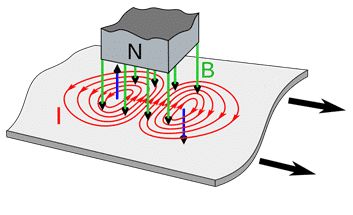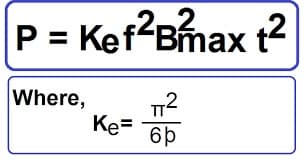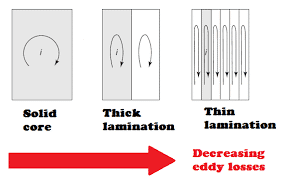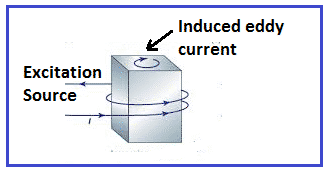What is Eddy Current?

Eddy Current Loss in Transformer
When the primary of transformer is fed alternating ac voltage, the varying magnetic field is set up in the magnetic core. The magnetic flux gets linked to both the primary and secondary winding of the transformer.

Bm = Peak Value of magnetic field
How to reduce Eddy Current Loss in Transformer

Properties of Eddy Currents
- Eddy current are induced only inside the conducting materials.
- These are distorted by defects such as cracks, corrosion, edges etc.
- Eddy currents attenuate with depth with highest intensity present at the surface.
- These properties lead to numerous applications of eddy currents in power, aerospace and petrochemical industries for detecting metal cracks and damages.
Application of Eddy Current
1.Magnetic Levitation
It is a repulsive type of levitation finds application in modern high speed Maglev trains to provide friction-less transportation. Changing magnetic flux produced by a superconducting magnet placed on the moving train produces eddy currents on the stationary conducting sheet over which train levitates. The eddy currents interact with the magnetic field to produces forces of levitation.
2. Hyperthermia Cancer Treatment
Eddy current heating used for tissue heating. Eddy currents induced in the conducting tubing by proximal wire winding connected to a capacitor to form a tank circuit which is connected to a radio frequency source.
3.Eddy Current Braking
Kinetic energy converted into heat due to eddy current losses finds numerous applications in industries. For example –Braking of trains,Braking of a roller coaster and Electric saw or drill for its emergency shut-off.
4. Induction Heating
It is the process of electrically heating a conducting body by inducing eddy currents in it using high frequency electromagnet. Its main applications are induction cooking, induction furnace used to heat metals to their melting point, welding, brazing etc.
5. Eddy Current Adjustable Speed Drives
With the help of feedback controller an eddy current coupled speed drive can be achieved. It finds applications in metal forming, conveyors, plastic processing etc.
6. Metal Detector
Eddy current detects presence of metals inside rocks, soils etc. with the help of eddy current induction in the metal if present.
7. Data Processing Applications
Eddy current non destructive testing used in investigating composition and hardness of metal structures.
8. Speed Sensing Applications
Speedometer and Proximity Sensing Applications
Related Posts
